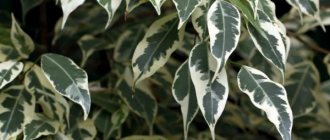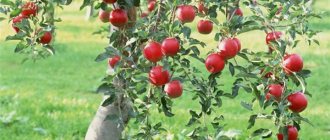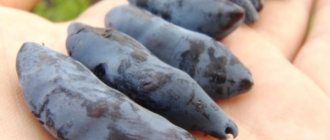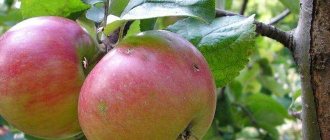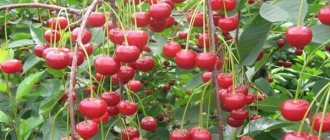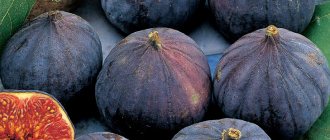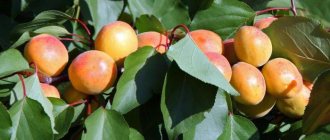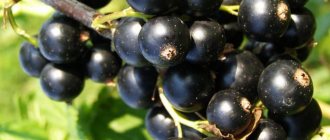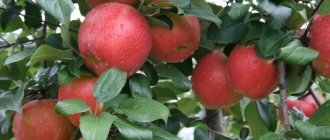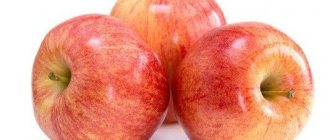Bushes and trees
0
382
Article rating
Kira Stoletova
Siberian larch (in Latin Larix Sibirica) is a coniferous gymnosperm tree belonging to the Pine family. Due to its large size in landscape design, it is mainly suitable for decorating park areas. It is rarely used for landscaping small garden plots.
Siberian larch: what the plant looks like and where it can be grown
Siberian larch
Siberian larch is a coniferous tree of the pine family from the genus Larch; its name in Latin sounds like Larix Sibirica. These giants grow up to 40-45 m in height, and the trunk diameter can reach 180 cm, but most often about one meter. In young trees, the crown, as a rule, has the shape of a cone, but with age it acquires a more rounded shape. Larch branches are usually spreading: they grow at an angle of 90° from the trunk, and then bend upward.
The trunk of the Siberian larch is erect; at a young age, the bark is usually smooth, light with a beautiful sandy or grayish tint; as the tree matures, the bark thickens to 25 cm, cracks, and darkens slightly. Larch wood is highly valued due to its high strength and resistance to decay; its core color is brownish-red with thin whitish sapwood. The thickness of the bark serves as a kind of shield, protecting the tree from adverse external factors: frost, fire.
Branches with shoots of 2 types: 1. Long - annual. On them the needles are located singly, in a spiral shape. The color of such shoots is usually yellow-green. 2. Short - perennial. The needles on such shoots have a bunch arrangement. Each such bunch contains from 30 to 50 needles. The lifespan of perennial shoots varies from 10 to 12 years, then they die off. Their color is gray-yellow.
The buds of Siberian larch are yellowish-brown or red-brown in color and broadly conical in shape. They are covered with scales and have a resinous structure. The needles are mostly soft, narrow, reaching a length of 3-4 cm. The color of the needles is bright green, with a characteristic bluish bloom, and there are rows of stomata on both sides.
The root system of Siberian larches is well developed, which allows these trees to withstand the strongest winds. On poor rocky soils, as well as on soils with an excess of moisture or near permafrost, the root system of Siberian larch is identical to the spruce root system. Near a swampy area with an abundance of moss, additional roots grow on the trunks of these trees - adventitious ones, which are located just above the root collar under a layer of growing moss. As moss grows and the roots of the tree sink deeper and deeper, their lower part dies over time, allowing adventitious roots to take over the function of feeding the tree.
Flowering time occurs in April - May and lasts for 1-1.5 weeks. At the same time, the needles bloom. Along the crown, heterosexual cones are distributed uniformly and evenly. Male flowers are usually connected in round spikelets of yellow color, while female flowers have the shape of a cone with a color ranging from violet-red to faint green. The peak ripening time for buds is September. Ripe cones have an ovoid shape and a rich brown color, their dimensions are small, about 4 cm. The scales, rounded at the top, taper closer to the base, convex, wooden, overlapping each other, have a length of no more than 1.5 cm. Seed dispersal occurs by mid-autumn - in October, but empty cones continue to hang on the tree for years.
The seeds have the following characteristics (on average):
- Length: 5mm
- Width: 3mm
- Wing: 7mm
- Color: yellow-brown
Siberian larch bears fruit almost every year. Productivity depends on the region where the tree grows, its age and weather conditions during the growing season; the seed collection rate varies from 15 to 80 kg per 1 ha. The tree begins to bear fruit for the first time at 12-50 years of age, depending on conditions and location.
Siberian larch is a monoecious deciduous plant. Grows quickly, loves light, pollinated by wind, winter-hardy, not demanding on soil fertility, but humidity is of some importance. These trees improve the quality of the soils in which they grow. The lifespan of these giants reaches up to 900 years, but this is the maximum figure; on average, it is 400 years.
Fine-scaled or Japanese larch
Native to Japan, it is a hybrid between European Larch and Japanese Larch. Coniferous tree, its height is up to 30 meters. The branches are long, horizontally spaced, bright red-brown in color, forming a wide-cone-shaped crown, the top of which is slightly flattened. Young shoots are brownish-light brown to reddish-violet.
The needles, 1.5-4 cm long, are narrow-linear, soft, blue-green in color, collected in bunches of 15-50 pieces on short shoots. The plant “blooms” in April. Male spikelets (anthers) are cylindrical or ovoid, small, yellowish in color. Female cones are very thin, 2-3.5 cm long, ovoid in shape and yellowish in color. The seed scales are fragile, thin, reddish-light brown in color, in the upper part they have an edge bent outward (this is how Thin-scaled Larch differs from other larches). Covering scales are ovoid or lanceolate-pointed, reddish-brown in color, almost half as long as the seed scales. This larch begins to bear seeds at 15-20 years of age. The seeds (their length is 3-4, up to 5 mm) have a shiny, brown wing. 1000 seeds weigh 3.7-4.6 grams.
Larch A thin-scaled, fast-growing, shade-tolerant, frost-resistant species. Does not suffer from late spring frosts at all. Little demanding of soil, but loves deep, fresh, sandy and clay soils. In nature it grows on the slopes of mountains in Japan (on the island of Honshu), rising to a height of 1700-2400 meters above sea level. In the nature of Russia it can rarely be found in experimental forest plantings. In Japan, it is widely cultivated in forestry, and its decorative dwarf forms are used as indoor plants.
In Russian culture it grows well where European Larch is planted in city parks, in single plantings or in small groups. It is known that in the arboretum of the Moscow Agricultural Academy at the age of 50 it had a height of 20 meters and a trunk diameter of 27 cm. In Kiev in the botanical garden at the age of 30 its height reached 14 meters, the trunk diameter was 34 cm. Known forms:
- Haphofera - the crown is of a regular conical shape, the branches are vertically raised;
- Dense – bushy, rounded shape;
- Weeping - the main branches of the crown are drooping; very decorative form, effective as a solitaire.
Spreading
Siberian larch has a very wide growing area. Naturally, it is most often found throughout Siberia, but encounters with it from the south of Russia to the forest-tundra are also not uncommon. It is capable of living at an altitude of 2500m above sea level, rising high into the mountains. Altai and Tien Shan are also not spared from Siberian larch.
Over a wide area of their geography, these trees form the purest forests; in addition, they grow in friendly neighborhood with other coniferous representatives: pine, spruce, cedar, as well as fir and birch, and so on.
Siberian larch in landscape design
Ephedra is planted in open spaces for landscaping gardens, parks, and public gardens. To give a decorative appearance, they resort to crown formation. The color of Siberian larch needles varies from gray to light green. This is also taken into account when creating landscape compositions.
The culture can be placed in a container and small rock gardens can be created with it. In such conditions, Siberian larch becomes the dominant plant. It tolerates changes in air and soil temperatures well.
Comment! Siberian larch grows well next to birches, Siberian cedars, lindens, maples, fir, spruce, and juniper.
Collection and preparation
Larch has medicinal properties:
The needles are collected throughout the whole summer, but the most favorable period is the end of June or early August, since it is then that the needles are richest in ascorbic acid. At the beginning of spring, it is advisable to collect buds and shoots (young), at this time the scales are still pressed tightly against the bud.
The resin is collected as follows. During the growing season, a notch is made on the trunk, from which the resin flows. The bark is obtained from felled trees by carefully removing it.
Drying of raw materials is carried out at a temperature of no more than 25° in a closed room with minimal humidity, or in an open space. This applies to needles, shoots and buds, although a greater effect is achieved when using fresh raw materials, but the shelf life of raw material is extremely short. Storing the twigs at a temperature of 20°-25° leads to the destruction of the vitamins in them within three days.
The use of bark requires heat treatment: boiling, steaming, and only then drying at room temperature. Heat treatment allows you to destroy small pests that can live in the larch bark. Raw bark has a long shelf life if the necessary conditions are met, one of which is storage in the refrigerator.
Related article: Muttereich description and features
Landing rules
Selection of seedlings
The key to successful growth, development and high decorativeness will be high-quality planting material.
You can buy real larches with all varietal characteristics at a gardening nursery or a specialized store.
Price for one copy:
- height from 1 to 2 m - about 2800 rubles;
- 2-3 m - 4500 rub.
When choosing young trees, it is necessary to give preference to plants 2-3 years old, preferably with closed roots (in a container or with a ball of earth). Such seedlings have good and rapid survival after transplanting to the site.
Seedlings must be purchased from a nursery
The crown should be lively with needles of a uniform color. The shoots and central conductor are free of breaks, cracks, growths and rot. The root ball of healthy conifers does not contain acidification or mold.
Before planting, the plants are saturated with moisture - with closed roots using the sprinkling method, with open ones - dipped in a container of water for an hour.
Preparing the site
The tree can be successfully cultivated in any place - under the sun or in partial shade. But in order to achieve maximum decorativeness from it, you should choose a sunny corner with shading at lunchtime - this way the beautiful and delicate needles will retain their original color and will not fade.
The root system is powerful, going 2-3 m deep. To prevent its decay, you need to choose an area with deep groundwater - up to 3.5 m.
Ephedra can grow on sandy loam, loam or rocky soil.
- If the soil is sandy loam, its composition can be improved with clay - add a couple of buckets per 1 m².
- Add 20 kg of sand and peat to the clay one.
The optimal soil acidity is 6 units; if the value is higher, the planting area is sprinkled with calcite, powdered chalk or slaked lime at the rate of 400 g per 1 m². After this, it is necessary to carry out deep digging, leveling and watering.
Landing technique
The best time for planting is spring, at the end of April or early May. In the southern regions, autumn planting is allowed - in early September.
- A couple of weeks before the planned movement of seedlings into open ground, holes are dug, two times larger than the earthen ball.
- A drainage layer of pebbles, crushed stone and screenings is poured onto the bottom. Then half the volume is sprinkled with a mixture of peat, turf, coarse sand and pine sawdust in a ratio of 2:2:1:1. To increase nutritional value, you can add 100 g of superphosphate and potassium sulfate.
- The soil mixture is spilled with water at the rate of 10 liters per hole. As soon as it is absorbed, the root system is lowered, all voids are covered with earth, compacted around the trunk and moistened. One seedling uses two buckets of water.
To prevent conifers from getting sunburned, in the first weeks after planting they need to be shaded with burlap or agrofibre.
When planting, it is important that the root collar remains above the surface of the soil, otherwise it will quickly rot and die.
If you plan to plant several seedlings, you should maintain a distance between them of at least 4 m, in a row - 3 m.
Medicinal properties
Siberian larch has excellent healing properties. The use of preparations based on raw materials from Siberian larch have many therapeutic effects:
- enveloping
- painkillers
- laxative
- antimicrobial
- anti-inflammatory
- anthelmintic
- wound healing
- antitoxic
- antiviral
- gynecological
- hemostatic
Larch needles contain useful substances such as: vitamin C, essential oils, adhesives. The bark is rich in elements such as: Catechins, Gum, Flavonoids, Organic acids, Tannins.
Resin has a healing effect due to the content of the following products in its composition: Rosin, Essential oils, Abietic acid, Fatty acids: palmitic, oleic, linolenic.
The use of larch as a medicine is due to the fact that individual parts of this tree have significant medicinal properties and are used in the treatment of many diseases.
Needles are an excellent remedy for diseases such as:
- Hypertension
- C deficiency
- Scurvy
- Periodontal disease
- Smell from the mouth
Young shoots can help in the treatment of such ailments:
- Cough
- Bronchitis
- Urolithiasis disease
- Helminthiasis
- Flatulence
- Constipation
- Rheumatism
- Gout
- Neuralgia
Larch resin has a truly miraculous effect in the treatment of:
- Sore throats
- Gingivitis
- Open wounds
- Inflammatory diseases
- Poisoning
- Diseases of the gastrointestinal tract, including: gastritis, duodenitis
- Viral diseases
- Gout
- Rheumatism
- Muscle inflammation
- Neuralgic diseases
- Respiratory diseases
- Abscesses
Siberian larch bark is a good panacea for the following health problems:
- Excessive menstrual bleeding with severe pain
- Diarrhea
- Intestinal infections
- Radiculitis
- Headache
- Toothaches
- Encephalitis
- Kidney diseases
- Heart and liver diseases
Larch sponge, which is a tree fungus growing on the larch trunk, allows you to defeat many diseases, including:
- Lung diseases: tuberculosis
- Heavy bleeding
- Constipation
- Sweating is excessive
- Boiling larch knots for 48 hours is an excellent cure for excruciating pain in the head, heart, as well as liver and kidney diseases. This decoction should be taken three times a day, one teaspoon.
- Festering wounds and ulcerations, a tendency to develop boils, eczema, burns, cracks in the skin can be overcome with an ointment based on Siberian larch resin. To do this, you need to mix larch resin, yellow wax and propolis, as well as sunflower oil, taken in equal proportions, and melt it all in a water bath. Once cooled, this mass becomes an excellent medicinal ointment, which should be applied externally to the affected areas; you can also make compresses.
- Larch resin can cope with painful toothache; you need to chew it and put it on the sore tooth. The pain subsides after a couple of minutes.
- The resin is also used in the treatment of hemorrhoids. By kneading the resin and molding it into something like a rectal suppository.
- Bronchitis, pneumonia, cough, tuberculosis and other pulmonary pathologies can be cured by the resin of Siberian larch. You can use it by inhalation or boil it in milk and drink it three times a day.
- The resin, which must be swallowed 3 times a day before meals, 50 grams, can cope with gastric diseases: heartburn, duodenal ulcers, and so on.
Features of care
All care for Siberian larch comes down to several manipulations - systematic moistening, fertilizing, loosening and pruning.
Watering
For successful survival, it must be frequent - every other day in the first two weeks. For the next month, moisturize once every 7 days. Subsequent moistening is carried out as the soil dries to a depth of 6-7 cm.
Starting from the age of three, conifers are watered up to four times per season - 10 buckets of water are poured under one tree. This takes into account if the summer turned out to be dry.
Additionally, regular sprinkling is required in the evening. A crown saturated with moisture better develops young growth, looks attractive and is protected from parasite invasion.
Loosening and mulching
The first procedure is necessary to keep the soil light to provide access to the roots of moisture, oxygen and nutrients. Loosen the soil a day after watering.
Then add peat mulch mixed with pine chips. It will protect the soil from rapid evaporation of water and prevent the growth of weeds.
Additionally, regular removal of unnecessary vegetation, fallen trees and weeding of row spacing is required.
Feeding
The plant does not need to be fertilized for the first three years.
Starting from the fourth year of life, the crop is fed with organic and mineral fertilizers.
- The first feeding is carried out every spring (late March or early April). 500 g of urea, nitroammophoska or azofoska are embedded in the near-trunk zone of the plant.
- In summer, during the phase of intensive growth of needles and young shoots (in mid-July), 350 g of superphosphate and potassium sulfate are added.
- In the fall, 3-4 weeks before the expected frost, an area of 1 m² is sprinkled with the same composition as in the summer.
Each root feeding is combined with abundant watering. Water helps to quickly absorb the active components and protects the root system from burning.
Additionally, you can carry out several foliar feedings with preparations containing chelates (Epin, Heteroauxin or Epin-extra). Irrigate the crown in the evening, when the sun sets, and no more than three times per season.
Trimming
This tree does not need shaping, but sanitary pruning in early spring is a mandatory care procedure. They cut out all questionable branches - frozen, broken, shriveled and disease-damaged.
Use a disinfected and sharp instrument.
At the end, the crown is irrigated with a solution of copper sulfate to prevent infection. After half an hour, spray with Epin, which helps the tree return to normal faster.
Preparing for winter
Adult conifers from three years old have high frost resistance, so they do not require insulation.
On the eve of cold weather, young plantings are covered with garden soil or peat, then the branches are collected together, bent to the central conductor, and tied with twine. For the winter, cover the crown with burlap or spruce branches so that the wood does not freeze and the needles do not freeze.
The material is removed in the spring, when the snow thaws and the threat of return frosts has passed.
Contraindications
- Individual intolerance
- Intestinal and stomach ulcers
- Post-stroke and post-infarction condition
- Central nervous system diseases
- pregnancy and lactation period
- Ambrosia pigweed
Ambrosia goosefoot is a perennial herbaceous aromatic poisonous plant of the goosefoot family. It grows in the countries of North Africa, Brazil, Chile, USA,…
Chernogolovka vulgare
Common blackhead (black gourd, etc.) is a perennial herbaceous plant of the Lamiaceae family. Classified as poisonous! Grows in fields, forest edges,…
Gardenia jasminoides
Gardenia jasminoides is an evergreen shrub of the Rubiaceae family. In nature, gardenia grows in China, Japan, Vietnam, and in other countries...
Corydalis
Corydalis (chubata empty, etc.) is a perennial or annual herbaceous plant of the Poppy family. It is poisonous and honey-bearing. Grows in…
Some general information
Siberian larch is part of the Pine family, and has all the distinctive features of the genus - it grows in the shape of a spruce or cedar, and has needles instead of leaves. Although, in fact, its needles are nothing more than leaves of a peculiar type. The transformation of leaves helped trees adapt to the sharp cooling that occurred on the planet 20-25 thousand years ago. Therefore, scientists consider conifers to be the most ancient on Earth.
But, apparently, at that moment something went wrong with the larch, and it began to shed its needles every year, differing in this feature from other members of the family.
As you know, the needles of evergreen trees are covered with a waxy coating, which contains cutin, a substance that prevents moisture evaporation and protects the needles from frost. Larch does not produce cutin, the plaque on its needles is almost invisible, as a result, the tree is forced to shed its needles every autumn.
As a rule, needles fall off the Siberian larch in October, while its closest relative, growing on the American continent, loses its needles in November.
Larch is not the only coniferous tree that gets rid of its needles in the fall. Similar behavior is observed in kaempfera (false larch), taxodium, metasequoia, and some species of the Cypress family. Seasonal shedding of needles occurs for various reasons.
As for the Siberian larch, it actually grows in the harsh climate of the Urals, Siberia, the Far East, and the European part of Russia, where nature places special demands on trees.
The tree grows together with other members of the family - spruce, pine and cedar, but sometimes forms separate forests. If you happen to visit the Siberian taiga in winter and find an entire forest of coniferous trees without needles, do not rush to sound the alarm and talk about an environmental disaster and dead trees. In spring, the trees will come to life and be covered with fresh leaves and needles.
Article on the topic: Pear pear description and features
Diseases and pests of larch
Leaf leaf miner. The needles become white and flabby. Damaged shoots should be removed, and in case of severe damage, treated with a solution of any insecticidal preparation made on the basis of mineral oils.
Also a group of insects related to aphids called pine bugs. It is not difficult to recognize mealybugs - they “wear” white fibrous shields on their backs that protect them from predators. These pests can also be found on fir and spruce trees. In some dry years, when rain does not knock the scale insects to the ground, they multiply in such numbers that the branches seem to be covered with frost. With such severe damage, you should resort to insecticides.
In the spring, in April, larch trees are often infested by hermes, a type of aphid that “specializes” in feeding on the sap of conifers. In places where it accumulates, the needles become bent and turn yellow. Larch spider moth caterpillars are recognized by their thick web cocoons. The striped larch sawfly damages needles. To combat these pests, trees are sprayed with actara.
Larch moth caterpillars eat the needles in the spring. In this case, spraying with actara at the end of April - May helps. And again in June, during the season when butterflies emerge from cocoons.
Against bark beetles, pine beetles and longhorned beetles, trunks, crowns and tree trunk circles are treated with karbofos. This is done in the spring, before pests appear after wintering.
The Schutte fungus attacks larch at high air humidity. In May-June, red-brown spots appear on the needles, then they turn yellow and fall off. To prevent this from happening, in July-September the trees are sprayed with proton, hom, thiovid-jet, complex (gamair, alirin, trichocin, gliocladin) or Bordeaux mixture.
Larch trees are treated with copper sulfate or nitrophen against parasitic fungi (root sponge, bordered tinder fungus, “Jew-dino ear” fungus) that cause rotting of the trunk and roots. Severely affected specimens have to be uprooted.
Shoots of large larches (European, Siberian, Western and Japanese) that have just begun to grow can be damaged by late spring frosts, but the trees recover in the same summer. The more graceful Daurian, Olginskaya and American larches do not suffer from frost at all.
Description of appearance
Siberian larch grows up to 40 meters, it has a powerful trunk with a diameter of 80 to 180 cm. The crown is pyramidal, but becomes round with age. The bark of old trees is brownish, thick, with grooves and cracks. In young people it is light, yellowish and smooth.
The needles are soft and light green in summer, and yellow in autumn. In the spring, immediately after their appearance, the needles have a pleasant and delicate aroma of citrus fruits. The length of the needles is up to 4.5 cm, they grow in bunches of 30-40 pieces. The needles are not rich, so the tree does not provide strong shade.
The tree is monoecious; the male spikelets are little noticeable; the female spikelets, on the contrary, attract the eye with their red or pink color. They do not hang like spruce trees, but grow upward - the same feature is found in cedars. In the photo there are larch cones:
Over the summer, in August-September, small seeds with wings ripen in the cones, but even when they fall out, the old cones continue to hang on the tree for another 2-3 years, after which they fall to the ground and remain intact. Seeds are not formed every year, this happens once every 2-3 years, and in the northern regions - once every 6-7 years. The ability to form seeds in larches growing in forest stands begins at 30-50 years, in lonely trees - at 15-20 years.
The larch root is powerful and taprooted. The structure of the root system depends on the type of soil; in light, sandy soil it will be branched, in hard soil it will take the form of a rod going deep into the ground. Regardless of the structure of the roots, the tree is wind-resistant.
It grows quite quickly, the first 3 years the growth is not large, 100-120 cm, but in subsequent years it is 45-50 cm annually. Active growth occurs in the first 30-40 years, then slows down. Excessively dry or too wet soil interferes with the active growth and development of the crown.
In good conditions and in places safe from fires, a tree can live up to 1000 years, but on average its life spans 500-700 years.
Kuril larch
It grows in the south of the Kuril Islands, on Sakhalin, on the Okhotsk coast, Kamchatka, and Japan. Coniferous, summer-green tree of the pine family, 25 (30) meters high, trunk diameter 50-80 cm. Long branches are horizontally spread, forming a wide, ovoid-cone-shaped crown. Larches with flat crowns, similar to huge umbrellas, are also found on coastal terraces. Young, elongated, densely pubescent shoots, pinkish or reddish in color, with a bluish bloom; shortened - densely located, up to 1 cm long, 4-5 mm in diameter. The buds are not resinous (less often, low-resinous), shiny, dark brown or almost black in color.
The needles are flat, linear, collected in bunches of several dozen. On a short petiole it is shiny, dark green on top, yellowish below. Without a petiole, soft, both sides are the same color. The cones are small, slightly scaly (have 10-15 scales), ovoid, light brown in color, 1-2 cm long. The upper edge of the flat seed scales is straight or slightly deflected outward. The weight of 1000 seeds is 2.5-2.8 grams. Kuril larch is not picky about soils.
It grows well on peat and marshy soils, where there is no permafrost, on sandy soils, on pebbles, and volcanic ash. This is a fast-growing ornamental tree that grows in nature, in lowlands, hills, river and sea terraces, and rises to the mountains no higher than 350 meters above sea level. It grows well in cultivation in Estonia and Leningrad; in Crimea it could not grow due to the dry air.
Application
We can talk about the use of larch in two aspects - the tree has high-quality wood and a set of healing substances that are useful for humans. As for cultivation, larch looks good next to birch trees and other trees whose leaves turn crimson or yellow in the fall. However, the sight of a yellowing coniferous tree brings to mind the past New Year holidays, and the need to finally take out the tree.
First, let's talk about wood. In terms of mechanical strength, it is quite slightly inferior to oak wood, and after drying it practically does not rot. Structures made from deciduous logs stand intact for up to 500-600 years, and no atmospheric influences can destroy them.
Durable and moisture-resistant larch wood is used for the production of piles and sleepers; larch posts last a long time in both fresh and sea water. Sea animals do not sharpen them because of the gum, so the material has long been used for the construction of wooden ships and boats.
At the same time, the presence of gum slightly spoils the properties of the material, it is difficult to process, it warps and cracks during rapid drying. To remove gum and improve the quality of wood, it is soaked for a long time or simply kept in rooms with high humidity.
Deciduous wood can be used to make utensils for saunas and baths; under the influence of steam and moisture, phytoncides will be released from such products, which have a beneficial effect on the human body and destroy bacteria and viruses.
There is not much cellulose in wood, so it is not used for paper production. But the bark contains a lot of tannins, more than oak, alder, willow and spruce.
On larch, more often than on other trees, you can find a fungus that parasitizes and destroys the trunk - a sponge, which forms growths on it that have a bitter pulp. The substance agaracin, used in the treatment of tuberculosis, is obtained from this pulp.
There is a lot of resin in the tree, cuts are made on the trunk, through which the resin flows out, and its extraction from one tree lasts a long time. Larch is able to withstand such donation.
Resin is used in paint and varnish production, for the production of soap and other household goods. In addition, it is used as a medicine in the treatment of certain diseases.
Versatility
Due to the fact that larch tolerates any weather conditions well and does not rot, it can be used in the construction of any houses, cottages, gazebos, terraces and much more. It is perfect for constructing interior partitions. Larch boards can be used to lay parquet, a walkway, an area near a pool or a barbecue. This material can be used with equal success for both external and internal work.
Larch is a unique natural material with unparalleled physical and technical properties. The scope of application of this wood is very wide, which makes this material literally universal. The cost of larch is quite moderate. Of course, the wood of this tree is more expensive than pine, but much cheaper than oak and ash.
Treatment with larch
Preparations from larch can cure many diseases that plague people. The drugs have analgesic, enveloping, and laxative properties. They can destroy a lot of bacteria and viruses, stop inflammatory processes and heal wounds.
This is facilitated by the beneficial substances contained in various parts of larch - vitamin C, gum, flavonoids, organic acids, essential oils, tannins.
Decoctions and tinctures from larch needles help with high blood pressure, scurvy, periodontal disease, vitamin deficiency, and bad breath.
Young shoots are used to treat cough, respiratory diseases, urolithiasis, flatulence, helminthiasis, constipation, neuralgia, gout and rheumatism.
Contraindications are individual intolerance, stomach ulcers, conditions after stroke and heart attack, diseases of the central nervous system, pregnancy and feeding.
The magic of larch
I wonder how in the old days they treated wood with unusual properties? It was not possible to find much information about the magical properties of larch. Apparently, our ancestors did not really believe in the power of the tree, which was never able to become fully evergreen. Larch seemed to have stopped on the path to perfection, and could not achieve what its other relatives from the Pine family managed to do.
However, there is no negative attitude towards this tree in legends and myths. In addition, it was impossible to ignore the high-quality wood of the tree. Not only boats and utensils were made from it, but also amulets and amulets. In a house where many misfortunes occurred, larch branches were burned to drive out evil spirits.
Inhaling this smoke, the shamans entered a trance and temporarily moved to another world, where they consulted with spirits on issues vital to the tribe or individual.
Article on the topic: Gymnocladus dioecious description and features
Among the peoples of Siberia and the North, the modest larch was considered a feminine tree, capable of calming, hugging with its soft branches, and setting one in a positive mood.
Modern bioenergy specialists also talk about the calming properties of larch. They advise you to come closer to her and just stand next to her, thinking about your problems. Larch will hear disturbing thoughts and tell you how to solve a difficult life problem.
Decorative varieties
For planting in your own garden, it is better to choose a variety of larch that will not take up much space and at the same time will look original and beautiful. Such varieties of European larch as Repens and Kornik fully meet these requirements.
Repens is a low, up to one and a half meters, creeping plant with shoots spreading along the ground. The width of its crown is only 60-80 cm. You can purchase a standard form, the branches of which grow downward like willow and other weeping trees. The height of this tree will depend on the height of the trunk, plus 20-25 cm due to growing shoots. Such a tree, and even hung with red cones, will puzzle both garden owners and guests with its appearance:
The Repens variety is grown in small gardens and rock gardens, in open ground, or in a container.
The root has the same height, but the crown is slightly wider - up to 120 cm. This tree does not “cry”, it is full of optimism and stretches its branches towards the sun:
Tree care
After planting, caring for the young tree is important. And an adult plant also needs to comply with basic agrotechnical rules, which gardeners need to know about.
Watering
Young trees require regular watering. If the larch is planted in a warm period (spring, summer), it needs to be watered 2 times a week. In this case, it is important to thoroughly wet the soil to a depth of 60–70 cm. Each tree will need about 2–3 buckets of water. To make the process more effective, you need to dig a small depression around the trunk and apply water directly into it.
After watering, the ditch is covered with earth and mulched with a layer of at least 5 cm to conserve moisture. Mature trees do not need watering - natural precipitation is enough for them. It is advisable to spray decorative low-growing crops with cool water in the evenings during hot periods - this way the needles will rest from the summer heat and the tree will not be attacked by spider mites.
Important! Before wintering (at the end of November), it is recommended to carry out moisture-charging watering, spending up to 5 buckets of water on each tree. This is necessary because in conifers life processes do not stop in winter, but only slow down.
Fertilizer
To prevent larch from getting sick and to show off its lush needles, it is useful to periodically fertilize the soil around the tree with phosphorus and potassium compounds. Kemira is suitable as a complex fertilizer. Treatment is carried out in early May, using 20 g per 1 m².
At the beginning of summer, you can treat the crown with a solution of urea or Quantum. In principle, these feedings are quite enough for larch, because it is not a fruit tree, and its needs are different.
Siberian larch (Larix sibirica Ldb)
The strength of this tree is 30-60% higher than that of pine. It is the only conifer that sheds its green cover for the winter. It can stay in water for a long time, only becoming stronger and harder. All this is Siberian larch.
This is the most common tree species in Russia. Its reserve is equal to approximately one third of all wood growing on the territory of the Russian Federation (28 billion m3 out of 82 billion m3, respectively). The distribution area is the Urals, in Western and Eastern Siberia, where up to 95% of the total grows. However, pure larch forests are quite rare. Much more often the tree grows in mixed coniferous forests next to pines, cedars and spruces.
In Rus', larch has long been used to build houses. With the development of shipbuilding, it began to be used to build ships. Only until 1862, 500 military ships were built from it in Arkhangelsk. Such majestic buildings as St. Isaac's Cathedral and the Winter Palace stand on larch stilts. Today, larch boards are considered primarily as a finishing material in the mid-price category
Botanical description
The tree can grow up to 35-40 meters in height. This is a light-loving plant that literally “reaches out” to the sun all its life, feeding on its life-giving energy. It is famous for its ability to withstand severe frosts down to -65°.
The trunk diameter varies from 80 cm to 1 m. Relative to other parts, the volume of the trunk is 77-82%.
With age, the pyramidal crown loses its clear outline and grows widely. As it grows, the bark becomes covered with deep longitudinal cracks.
The soft needles are colored light green with a bluish bloom and are collected in bunches. It falls in the fall. This way the tree retains moisture during severe winter frosts. This property distinguishes the tree from others from the Coniferous order. It was thanks to him that the tree received its name in our country - larch. While in Europe it is called Larix - “richly resinous”.
It is a monoecious plant in which single male spikelets are pollinated in the spring by globular female spikelets, colored purple or pink. The fruit, a cone, contains about two dozen scales from which seeds fall out.
Features of wood
In terms of its biostability, Siberian larch is somewhat superior to its closest “relative” from Europe. Resistance to decay is almost 1.75 times higher than that of oak, and 2 times higher than that of pine.
The main structural element is tracheids, the size of which in early wood is 52.4 microns in early wood, and 21.8 microns in late wood. Of all the conifers, larches have the thickest tracheid walls, which also explains their increased strength.
This is a soundwood with a thin layer of sapwood, the thickness of which varies from 8 to mm. the size of annual rings can vary: from 0.4 to 2.2 mm and depends on the natural growing conditions. The finished lumber has a rich texture and warm, vibrant colors.
The volume of late wood in larch can reach 39%, which also has a positive effect on its physical and mechanical properties.
The average values of the operational characteristics of Siberian larch are as follows:
Density 660 kg/m3.
Compressive strength along the fibers is 61.5 MPa.
Bending strength 97.8 MPa.
Tensile strength along the fibers is 120 MPa.
Hardness 24.9 MPa.
Elastic modulus 14.9 MPa.
The quality of Siberian larch is determined by the technical conditions GOST 8486-86 and GOST 24454-80. A smaller number of knots than other conifers provides a greater yield of high-quality lumber.
Processing larch wood is associated with a number of difficulties, one of which is the high risk of tools becoming greasy. In addition, the material is characterized by low adhesion and gluing ability. This, as well as the large difference in the density of the core and sapwood and low vapor conductivity, cause the species to be less in demand on the market than pine.
Application of Siberian larch
Currently, larch is used primarily as a finishing material, in hydraulic structures and in the production of yachts, and also as a raw material for the production of laminated veneer materials.
High-quality floor coverings are made from it using heat treatment. Wood is very popular in the West, in Scandinavian countries in factory-made wooden housing construction.
Primorskaya Larch
It grows in the Far East, Primorye, and the northern part of Sakhalin. The height of this coniferous summer-green tree is 10-12 (25) meters, the trunk diameter is up to 60 cm. The young shoots are bare, reddish in color, with a bluish bloom. The buds are shiny, non-resinous (occasionally low-resinous), brown in color.
The needles are flat, linear, collected in bunches of several pieces. The length of the needles is 2.5-3 cm. The upper side of the needles is dark green, the lower side is bluish. The cones are small, oval, 1.50-3 cm long, and have 25-30 scales. The seed scales are bare, flat, with a barely visible notch at the top. The seed and covering scales are equal in length. After the seeds ripen, the scales deviate at an angle of 40-50 degrees from the axis of the cones. The length of the seeds including the wing is 7-9 mm. The seeds are brownish-brown in color, the wing of the seed is reddish in color.
This is a fast-growing, fairly frost-resistant plant. In nature it grows on the slopes of mountains, in the Tatar Strait along the coastal ridge on the coast of the Sea of Okhotsk, in the Primorye region - along the banks of the Ussuri River. It has been known in culture since 1924; for example, in Leningrad at the age of three it had a height of 0.7-1.5 meters and grew faster than Siberian larch. Primorskaya larch has valuable resinous, straight-grained, moderately strong wood with wide, light pink sapwood and a red-pink core. Used for the manufacture of boards, beams, sleepers, mine racks, pillars, hydraulic construction logs. Primorskaya Larch is a hybrid form of Listvenintsy, which arose in natural conditions as a result of crossing Kamchatka Larch with Gmelin Larch and is an endemic species of Southern Primorye.
